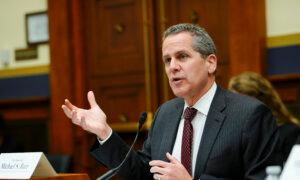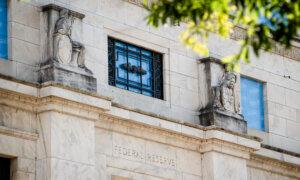From credit cards to mortgages, how will the Fed’s actions impact consumer finances?
News Analysis
The winds of change are upon the U.S. economy as the Federal Reserve is expected to cut interest rates for the first time in four years, affecting everyone from Main Street to Wall Street.
After the Fed launched its inflation-fighting crusade in March 2022, higher interest rates have significantly raised consumer borrowing costs, be it credit cards or auto loans.
While relief is on the way for borrowers, they should not expect the rate cut to be an instant cure, says Greg McBride, the chief financial analyst at Bankrate.
“By itself, one rate cut isn’t a panacea for borrowers grappling with high financing costs and has a minimal impact on the overall household budget,“ McBride wrote in an email to The Epoch Times. ”What will be more significant is the cumulative effect of a series of interest rate cuts over time.”
Forecasts for how fast or slow the central bank will be over the coming year vary.
The current benchmark federal funds rate ranges between 5.25 percent and 5.5 percent. So, if the traders’ prognostications are accurate, the economy could witness the policy rate falling to as low as 3 percent by next summer.
“Interest rates took the elevator going up, but they’ll be taking the stairs coming down,” McBride noted.
How will lower interest rates impact the typical household’s finances, whether the central bank is aggressive or conservative heading into 2025?
Mortgages
The Federal Reserve does not directly establish mortgage rates—but its actions can lay the groundwork for what lenders charge prospective homebuyers.
The monetary authorities’ policy rate decisions affect the bond market, and fixed-rate mortgages track the benchmark 10-year Treasury yield. Over the last several months, traders have priced in a Fed rate cut, allowing mortgage rates to decline.
Since May, both the 10-year Treasury yield and the 30-year fixed mortgage have decreased by about 1 percent.
What the Fed telegraphs—from Chair Jerome Powell’s post-meeting press conference to the updated Summary of Economic Projections—could have a more significant effect on Treasurys and, by extension, mortgage rates.
If the Fed cuts rates more slowly than investors expect, home loan rates might not move much.
“But further declines could come at a more modest pace, and we’re not going back to the sub-3 percent mortgage rates of 2020 and 2021,” McBride stated. “While lower mortgage rates will help from an affordability standpoint, other variables like home prices and the availability of homes for sale will be just as important to prospective homebuyers.”
“Homebuyers, including a growing share of first-time buyers, continue to favor newly built homes, as declining mortgage rates in August contributed to the uptick in new home sales activity,” Joel Kan, the vice president and deputy chief economist at the association, said in a statement.
Auto Loans, Credit Cards
Over the last few years, households have taken on record credit card debt amid a sky-high cost of living.
Since the Fed’s short-term interest rates are linked to variable credit card interest rates, cardholders could experience a tepid decline in debt servicing charges by the end of the year.
Although car loan rates will start to slip when the Fed loosens policy, they will not suddenly crater to pandemic-era levels, says Jonathan Smoke, the chief economist at Cox Automotive.
Savings Accounts
According to Bankrate data, the national average savings account yield was 0.61 percent in September. However, the numbers vary by bank because the federal funds rate functions as a guide for financial institutions rather than a rule.
For example, many online entities have offered account holders an annual percentage yield (APY) as high as 5 percent. By comparison, the major banks, such as TD Bank, Wells Fargo, and Bank of America, have maintained an APY of as little as 0.01 percent during this cycle.
But experts say the Fed’s rate-cutting cycle will push the banks to modify their APY.
“Savings account rates may decrease as typically banks adjust their interest rates alongside the Fed,” Gates Little, the president and CEO of The Southern Bank, told The Epoch Times.
This could exacerbate the current trend of falling savings rates, which has been steadily declining since March 2021.
Stock Market
Estimates of the number of Americans owning stocks differ.
Whatever the case, the stock market’s performance can significantly impact the broader U.S. economy. And changing interest rates can affect Wall Street.
While the expected Fed policy pivot has had a noticeable impact on bonds, market watchers have different views on how the central bank’s rate cuts will influence the New York Stock Exchange.
Lower rates can be beneficial for stocks because they trim the cost of capital, says Michael Ashley Schulman, the chief investment officer at wealth management firm Running Point Capital Advisors.
“Interestingly, at least in the initial phases, it is often the smallest, junkiest, or weakest stocks—the ones that investors had left for dead—that rally the strongest when rates decline,” he recently told The Epoch Times.
Jon DuPrau, managing partner at Quantum Portfolio Management, told The Epoch Times that a relevant comparison today is the 1995–1996 cycle “when the Fed cut rates preemptively to cool the economy without triggering a recession.”
“In that period, large-cap equities performed well, and bond prices rose as yields declined,” DuPrau said.
As the cycle progresses, DuPrau said, investors will need to monitor various economic indicators to determine whether the United States is more likely to face a soft landing or a recession.
Nevertheless, heading into the Fed’s potential September rate cut, the leading benchmark indexes have performed well this year despite a few hiccups along the way.
Year-to-date, the blue-chip Dow Jones Industrial Average has surged about 11 percent. The tech-heavy Nasdaq Composite Index and the S&P 500 have rallied 18 percent and 19 percent, respectively.
But while interest rates play a crucial role for stocks, they are not the only factor investors should consider, says Rob Haworth, senior investment strategy director at U.S. Bank Wealth Management
In the end, Haworth notes, investors need to be prepared for potential near-term fluctuations in stock prices.
Original News Source Link – Epoch Times
Running For Office? Conservative Campaign Consulting – Election Day Strategies!


